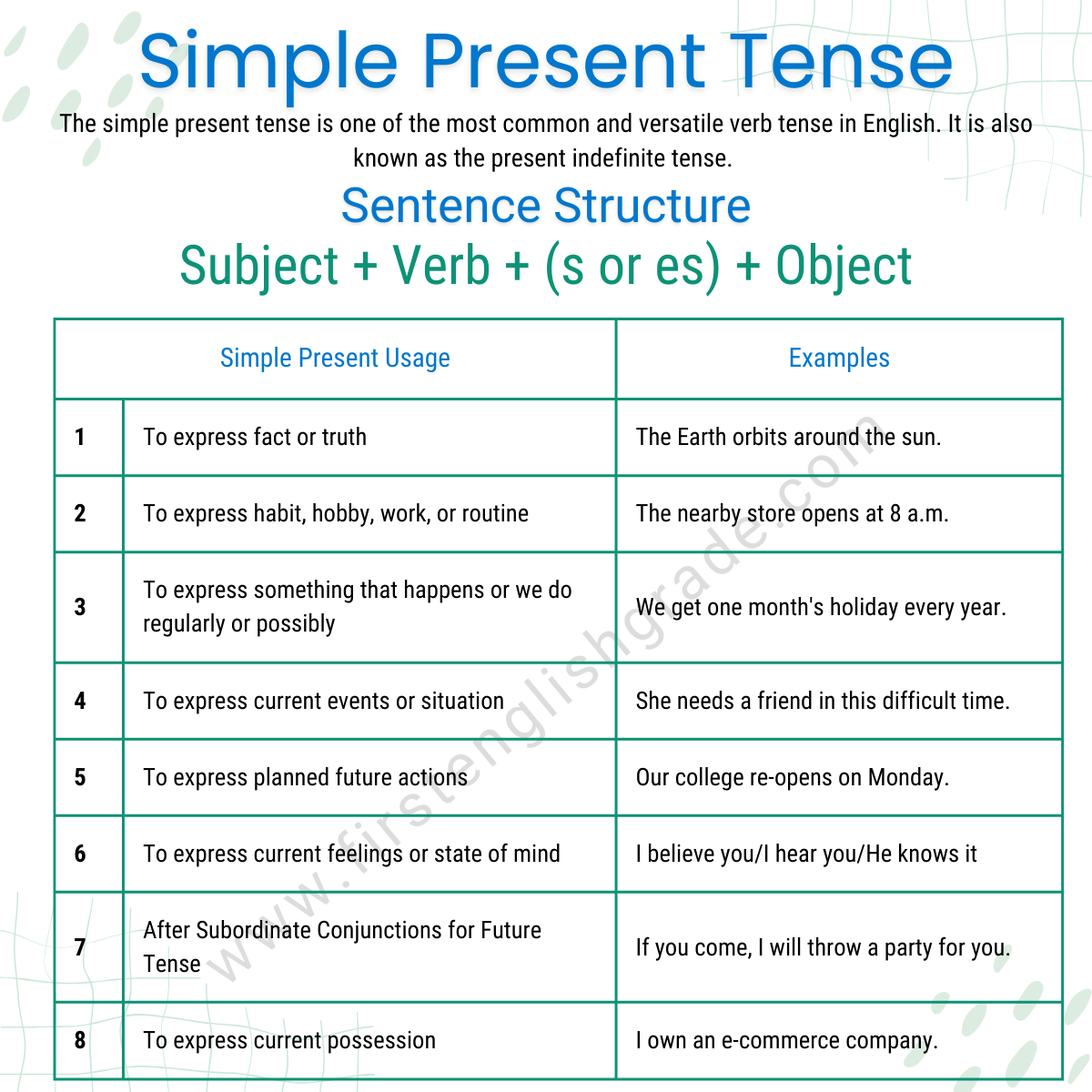
 First English Grade | An Online English Learning Resource" width="500" height="378" />
First English Grade | An Online English Learning Resource" width="500" height="378" />
The simple present tense is one of the most common and versatile verb tenses in English. It is also known as the present indefinite tense. We use simple present tense to express general truths, habits, routines, or facts. We can also use it to describe actions that are happening now.
Forming the Simple Present Tense is quite straightforward. Using the simple present tense rules and structure, you can form sentences.
These are a few simple present tense rules that you need to remember.
The Simple Present Tense uses the base form of the verb, known as V1. This form remains consistent regardless of the subject, except when addressing third-person singular subjects.
a) Adding “s”: When the subject is third-person singular (he/she/it/name), an “s” is added to the base verb. For example: He plays.
b) Specific Verb Endings for “es”: There are specific rules for certain verb endings. If the verb ends in “o, s, x, sh, or ch,” instead of adding “s” for the third-person singular, “es” is used. For example;
c) Changing “y” to “ies”: If the last letter of the verb is “y,” then replace it with “i” and then add “es”. That means we replace “y” with “ies.” For example;
d) Vowel before “y”: If there is a vowel ( a, e, i, o, u ) before “y” in a verb, add “s.” For example;
To form sentences in the Simple Present Tense, follow this structure:
Subject + Verb + (s or es) + Object
For instance: “She plays the piano.” (Subject: She, Verb: play + s, Object: the piano)
Let’s look at some of the examples of simple present tense. These example sentences express routine actions, facts, habits, or general truths in the present time.
The Simple Present Tense helps us discuss habits, routines, and general truths. It also describes actions that occur regularly or are happening right now. You can use this tense to describe your daily activities, beliefs, and thoughts about the world around you.
Let’s explore its various uses in detail.

Simple Present Tense is used to state facts or undoubted truths. The examples below are either facts or true statements…
This tense effectively portrays someone’s regular habits, hobbies, or daily routines. Below are a few examples that express someone’s habit, hobby, or routine.
We use the Simple Present Tense to express actions occurring consistently. Common time expressions that we use in such sentences are:
Always, every day, every week, every month, every year, sometimes, often, never, usually, once, twice, several times a week/month
Here are some examples expressing regular or frequent actions…
Use this tense to narrate ongoing events or current situations. Below are some examples that state current events or situations.
Simple Present Tense can also indicate planned future actions. In the examples below, we are talking about things going to happen in the future…
We express someone’s current feelings, or state of mind using the present simple tense.
When used with certain conjunctions, Simple Present Tense denotes future actions. Some subordinate conjunctions are: – as, as soon as, before, after, if, even if, unless, until, till, when
While we have covered affirmative sentences in the Simple Present Tense, it’s important to understand how to form negative and interrogative (question) sentences using this tense.
In the Simple Present Tense, we use the helping verbs “do” and “does” to form negative and interrogative sentences. The choice between “do” and “does” depends on the subject of the sentence:
Remember, when using “do” or “does” in negative sentences or questions, it’s important to match the appropriate helping verb with the subject to ensure proper subject-verb agreement.
The structure for negative sentences in the Simple Present Tense is as follows:
Subject + do/does not + base form of the verb + object
Note: “do not” contracts to “don’t,” and “does not” contracts to “doesn’t.”
It’s important to note that in simple present tense negative sentences, we don’t add ‘s’ or ‘es’ to the main verb. For example:
Simple Present Negative Sentence Examples:
To form interrogative sentences in the Simple Present Tense, the structure is:
Do/Does + subject + base form of the verb + object +?
Simple Present Interrogative Sentence Examples
The structure for interrogative negative sentences in the Simple Present Tense is as follows:
Do/Does + subject + not + base form of the verb + object +?
(Note: “Do not” contracts to “don’t,” and “does not” contracts to “doesn’t.”)
Simple Present Interrogative Negative Sentence Examples
Here are 20 sentences of simple present tense that you may use in your day-to-day conversations.
In the Simple Present Tense, you can use short answers rather than full sentences to respond to questions:
| Question | Positive Short Answer | Negative Short Answer |
| Do you get up early? | Yes, I do. | No, I don’t. |
| Does she work at this hotel? | Yes, she does. | No, she doesn’t. |
| Do they always come here? | Yes, they do. | No, they don’t. |
| Does he always bother you? | Yes, he does. | No, he doesn’t. |
| Do you drink coffee? | Yes, I do. | No, I don’t. |
| Does Susan stay late in the office? | Yes, she does. | No, she doesn’t. |
| Does he work at night? | Yes, he does. | No, he doesn’t. |
| Do they like each other? | Yes, they do. | No, they don’t. |
| Do you visit your parents every week? | Yes, I do. | No, I don’t. |
| Does Jonathan know you? | Yes, he does. | No, he doesn’t. |
The simple present tense, also known as the present indefinite tense is an English verb tense. It is used to express actions or situations that are habitual, general, or unchanging. In the simple present tense, the base form of the verb is used for most subjects. But, for third-person singular subjects an ‘s’ or ‘-es’ is added to the verb.
We use the Simple Present Tense for actions that are habitual, routines, scheduled events, general truths, or facts. For example: “She reads books every evening” (habitual action) or “The Earth revolves around the Sun” (general truth).
Yes, it can be used to talk about scheduled events or actions in the future when accompanied by time expressions. For example: “The train leaves at 9 PM tomorrow.“
To make a question in the Simple Present Tense, use the auxiliary verb “do” (or “does” for third-person singular) before the subject, and switch the subject and the base form of the verb. So, it goes like this: Auxiliary verb + subject + base form of the verb?
Making a negative sentence in the Simple Present Tense involves using “do” (or “does” for third-person singular) as an auxiliary verb. Then, add “not” after it. The structure is: Subject + auxiliary verb + not + base form of the verb.
Follow these general rules to form the third-person singular in the Simple Present Tense:
1. For most verbs, simply add “-s” to the base form (e.g., walks, talks).
2. For verbs ending in -s, -ss, -sh, -ch, -x, add “-es” (e.g., misses, fixes, washes, catches).
3. If the verb ends in a vowel + y, add -s (e.g., plays, stays, enjoys).
4. If the verb ends in a consonant + y, add -ies (e.g., tries, studies, cries).
In the Simple Present Tense, “do” and “does” are auxiliary verbs used to form questions and negative statements. The key difference between them lies in their usage with different subjects.
Do is used with: I, You, We, They
Does is used with: He, She, It